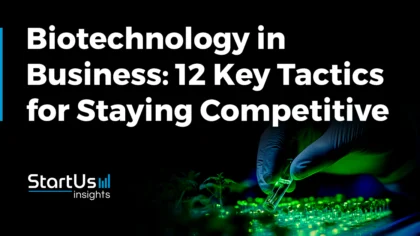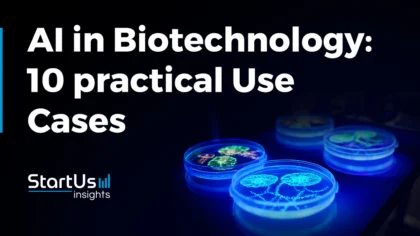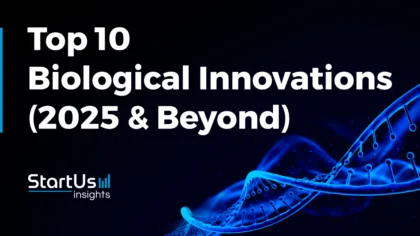The 2025 Genetics Outlook uncovers the current state, trends, and potential of the market. The study examines how genetic research and development affects pharmacogenomics, gene therapy, personalized medicine, diagnostics, and illness management, among other areas. Developments in bioinformatics and synthetic biology are further accelerating drug discovery, sustainable bio-based goods, and even engineered ecosystems. Additionally, the cost of genomic sequencing is decreasing, which leads to more research and the vast adoption of genetic testing in personalized healthcare. Along with the major innovations and trends, this report also covers market growth, emerging startups, and investment trends.
This genetics market report serves as a reference for stakeholders within the market, investors, policymakers, and economic analysts, providing a snapshot of the market’s health to map its trajectory for innovation and growth in the coming years.
StartUs Insights Genetics Outlook Report 2025
- Executive Summary
- Introduction to the Genetics Outlook Report 2025
- What data is used in this Genetics Outlook Report?
- Snapshot of the Global Genetics Market
- Funding Landscape in the Genetics Market
- Who is Investing in the Genetics Market?
- Emerging Trends in the Genetics Market
- 5 Innovative Genetics Startups

Executive Summary: Genetics Outlook Report 2025
This report is created using data obtained from the Big Data and AI-powered StartUs Insights Discovery Platform, covering more than 4.7 million global companies, as well as 20K+ technologies and emerging trends. We also analyzed a sample of 3300+ genetics startups developing innovative solutions to present five examples from emerging genetics market trends.
- Industry Growth Overview: The genetic field witnesses a yearly growth rate of -1.92%. In spite of that, there are 3300+ startups and 41 000+ companies working for its research and development.
- Manpower and Employment Growth: There are 3.5 million people worldwide working in the sector and 206 500+ were employed last year.
- Global Footprint: The United States, the United Kingdom, India, Brazil, and Germany are the top countries with the most activities in the genetic field. At a city level, New York City, London, San Francisco, San Diego, and Singapore are at the top.
- Grants and Patents: More than 99 000 applicants filed 1.18 million patents in the genetic sector. Additionally, the field also has 8000+ grants.
- Investment Landscape: The genetic sector holds over 12 900+ funding rounds and raises over USD 46.6 million in each round. This funding was used by more than 3300 startups.
- Top Investors: Leading investors include AstraZeneca, TPG, Softbank Vision Fund, Campbell Soup, Eli Lilly, KKR, Lubrizol, Biogen, Soaring Eagle Acquisition, and DNA. These investors made a combined contribution of USD 20.5 billion.
- Startup Environment: Innovative startups in the field include BioPhenyx (functional genetics), Sarmal (DNA sequencing technology), Arkus AI (genetic profiling workflow), Nuntius Therapeutics (mRNA therapy), and Mana.bio (lipid nanoparticles for drug development).
- Recommendations for Stakeholders: Investors should focus on funding technologies like CRISPR and gene therapy while diversifying portfolios to include companies with strong ethical guidelines and regulatory compliance. Entrepreneurs must capitalize on emerging trends by developing personalized medicine solutions and digital health platforms that integrate genetic data. Governments should prioritize funding for research and establish clear regulatory frameworks to ensure ethical practices.
Explore the Data-driven Genetics Outlook Report for 2025
The Genetics Market Report 2025 uses data from the Discovery Platform and encapsulates the key metrics that underline the sector’s dynamic growth and innovation. Our database covers 41 000 companies and 3300 startups, which indicates current growth and interest in the sector. The domain further records a growth of -1.92% in the last 12 months.
With more than 1.18 million patents and 8000+ grants, the genetic market hints towards a growing future of research and developments. The sector currently employs 3.5 million workers, and 206 500+ were added to the list last year. The main locations of research and development of the sector are concentrated in the United States, the United Kingdom, India, Brazil, and Germany. Cities like New York City, London, San Francisco, San Diego, and Singapore are the epicenter of activities in terms of cities.
What data is used to create this genetics market report?
Based on the data provided by our Discovery Platform, we observe that the genetics market ranks among the top 5% in the following categories relative to all 20K topics in our database. These categories provide a comprehensive overview of the market’s key metrics and inform the short-term future direction of the market.
- News Coverage and Publications: The genetic market produced over 31 600 newspaper and magazine articles in the last 12 months.
- Funding Rounds: There are more than 25 900 funding rounds recorded in our database.
- Manpower: The market employs more than 3.5 million people worldwide, and in the last year more than 206 500 new people have joined.
- Patents: More than 1.18 million patents have been issued for genetics-related developments, which demonstrates the field’s strong intellectual property environment and technological breakthroughs.
- Grants: The genetic market receives over 8000 grants.
- Yearly Global Search: The global search for the genetic market in the last year is 5.14%, which indicates a growing level of public interest in the discipline.
A Snapshot of the Global Genetics Market Report
The market records an annual growth of -1.92%. More than 3300 startups are working on research and development in genetics. Further, there are 2200+ startups at the early stage and more than 2200 startups at the merger and acquisition level.
Over 99 000 applicants filed 1.18 million patents, which shows a strong pursuit of research and development in the field. Additionally, the yearly record shows a growth of 1.94% in patent activity. Top issuers of patents include the USA with 345 900+ patents and China with 169 300+ patents.
Explore the Funding Landscape of the Genetics Market Report
The startups in the domain receive an average funding of USD 46.6 million. There are more than 15 100 investors in the genetics domain who participated in more than 25 900 funding rounds and supported 6300+ companies. The numbers show a promising future of more research and innovation in the discipline.
Who is Investing in the Genetics Market?
Together, the top investors in the genetics sector have contributed over USD 16.5 billion to genetics research and development.
- AstraZeneca supported 10 companies with USD 2.8 billion.
- TPG distributed USD 2.3 billion among 10 companies.
- Softbank Vision Fund spent USD 2.3 billion on four companies.
- Eli Lilly supported 33 companies with USD 2 billion.
- Lubrizol spent USD 1.8 billion on at least 1 company.
- Biogen spent USD 1.8 billion on 7 companies.
- KKR invested USD 1.8 billion across 17 companies.
- Soaring Eagle Acquisition invested USD 1.7 billion in 1 company.
Access Top Genetics Innovations & Trends with the Discovery Platform
- Next-Generation Sequencing has more than 900 companies. It records an annual growth of 12.99%. The current number of employees in the sector is 56 200+, and 4100+ new professionals joined the sector last year. This trend reshapes major processes like whole genome sequencing, targeted sequencing, transcriptomics, single-cell genomics, and more.
- Another major trend, CRISPR technology employs 28 100+ professionals. Last year, the CRISPR market hired 2700+ more professionals. The trend shows a yearly growth of 0.198% and currently has 600+ companies working on it. CRISPR is widely used to develop personalized medicine, gene therapy, allergen reduction, cure hematological diseases, etc.
- Synthetic Biology domain contains 2000+ companies. This market has 81 000+ professionals working in it currently and 99 000 more were hired last year. The yearly growth rate of this market is 6.74%. This trend is important for multi-gene modification, building artificial chromosomes, biopharmaceutical production, rapid screening and designing, etc.
5 Top Examples from 3300+ Innovative Genetics Startups
The five innovative startups showcased below are picked based on data including the trend they operate within and their relevance, founding year, funding status, and more. Book a demo to find promising startups, emerging trends, or industry data specific to your company’s needs and objectives.
BioPhenyx builds Functional Genetics
Denmark-based startup BioPhenyx has a proprietary technology, CRISPR-Select, which minimizes trial and error in drug discovery and application. CRISPR-Select introduces and quantitatively tracks a mutation of interest and neutral, internal control mutations to determine the final outcomes. The process occurs in an interesting cell culture, with or without a drug. The entire procedure takes 2 to 4 weeks. The result validates drug targets and determines the drug responder genotype.
The proprietary technology also has analytical capabilities to determine if a genetic sequence variant is pathogenic or benign, define drug resistance mechanisms, and decide if a drug acts through its intended target to draw out its effects. CRISPR-Select further performs knockin analysis, cell pool analysis, and absolute quantitation of cells with interest, internal, and control mutation. Professionals in clinic development, preclinic development, and patient-related diagnostics use the technology for cancer, metabolism, inflammation, and neurology cases.
Sarmal advances DNA Sequencing Technology
US-based startup Sarmal builds two platforms FLASH Sequencing and TEEM Target Detection, for nucleic-acid-based sequencing, and detection in genomics. The FLASH (FLuorescence Activation by Serial Hybridization) Sequencing platform monitors DNA replication in real time. During the sequencing, each fluorescently tagged nucleotide produces a unique signal, which is afterward converted into a digital signal.
This technology generates read-lengths of DNA without sacrificing accuracy. The TEEM (Target Enrichment by Electrical Modulation) platform integrates enrichment and detection for genetic testing. The platform reduces background improving the signal-to-noise ratio and making it easier to detect rare targets. It decreases off-target effects and false positives/negatives. These sequencing and detection platforms allow individuals to take control of their health by providing personalized, data-driven, and timely decisions.
Arkus AI automates Genetic Profiling Workflow
Swedish startup Arkus AI builds solutions to simplify genetic profiling workflow for personalized medicine and prevention. The intelligent solutions integrate deep learning and large language models with symbolic, knowledge-based methods to automate workflows including clinical decision support (CDS). The startup also offers a workflow tool that uses AI to merge the genetic and hereditary data of patients and create patient profiles.
The tool further streamlines genetic data collection, pedigree construction, consent management, and risk assessment. It also has a professional guidance tool for medical staff with resources to analyze and create personalized medicine for patients. Different sectors of healthcare providers like primary care, specialized clinics, hospital information systems, and genetics clinics use these solutions to automate genetic profiling procedures and increase accuracy.
Nuntius Therapeutics develops mRNA Therapy
Nuntius Therapeutics develops mRNA therapies using proprietary delivery technology, machine learning (ML), and nucleic acid engineering. The delivery development starts with programmable, scalable, and non-immunogenic nanocarriers targeting tissues and cell types beyond the liver.
Further, the trained ML models predict carrier quality and performance to determine the most suitable candidate from a collection. Then, the genetic payload system designs and engineers mRNA with protein expression levels. Nuntius Therapeutics develops this suite of therapies for treating cancer, lung diseases, and neurodegenerative diseases.
Mana.bio uses Lipid Nanoparticles for Drug Development
Israeli startup Mana.bio offers an AI-based drug delivery platform, which produces drugs suitable for gene therapy like DNA and RNA-based therapeutics, and vaccines. These genetic medicines are prepared by combining machine learning (ML) and lipid nanoparticle (LNP) design. The platform uses ML to design novel nanoparticles in silico that predict the properties of a good cell-specific, tissue-targeted LNP. After determining the LNP, it is synthesized and multiple formulations are produced using automated manufacturing pipelines.
The platform further examines the physiochemical properties of each LNP through an automated, high-throughput screening infrastructure. It continuously generates data while evaluating to improve the machine learning models. The AI-driven approach ensures precise formulations for the extrahepatic delivery of nucleic acid therapeutics and vaccines. Healthcare providers along with biotech companies, researchers, and pharmaceutical companies use the platform to cut down the time required for drug delivery.
Gain Comprehensive Insights into Genetics Trends, Startups, or Technologies
The 2025 Genetics Outlook provides insights into how research and developments in the sector are leading to more innovative drug development, treatment options, personalized cures, and more. With developments of artificial technology, methods like next-generation sequencing, and concepts like synthetic biology, the genetic field is set to see more innovations in the coming future. Get in touch to explore all 3300+ startups and scaleups, as well as all market trends impacting 41 000+ companies.









